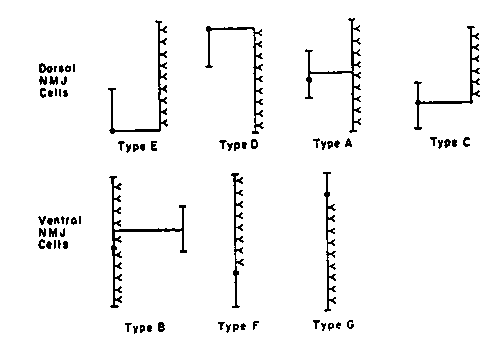Worm Breeder's Gazette 2(2): 30
These abstracts should not be cited in bibliographies. Material contained herein should be treated as personal communication and should be cited as such only with the consent of the author.
The motor nervous system of Ascaris consists of five sets of segmented neurons each containing eleven cells that make synapses onto muscle, together with six ventral interneurons that make synapses onto some of the motorneurons. The neurons can be divided into seven classes (see figure) that appear to be structurally identical to the seven classes in C. elegans, with the following equivalences . [See Figure 1] The dorsal n.m.j. cell types C, D and E receive interneuron input, but the A cell receives synapses only from ventral motorneurons. The ventral F and G cells receive input from interneurons; the B cells receive synapses only from dorsal motorneurons. All these output cells make synapses with muscle only in one nerve cord. Each segment has one copy of cell types A, D and E, and two copies of types B, C, F and G. Anatomical similarities (relative positions in nerve cords; details of the patterns of neuromuscular connectivity) are used to assign functional equivalences in the dorsal and ventral cords. [See Figure 2] The function of types of A, B, C, D and E neurons has been determined physiologically (see Walrond and Kass). The motorneuron synapses onto the inhibitory neurons provide pathways for reciprocal inhibition, between both cords, that is generated peripherally rather than centrally. [See Figure 3]


